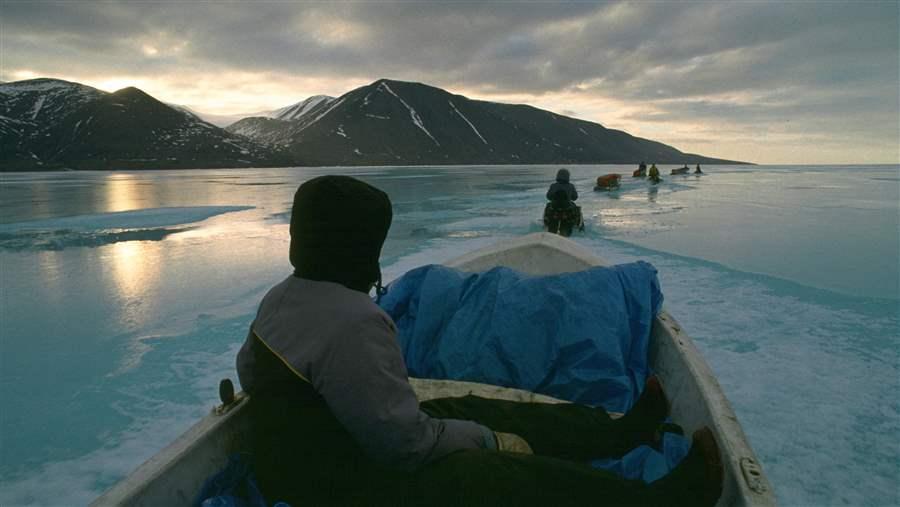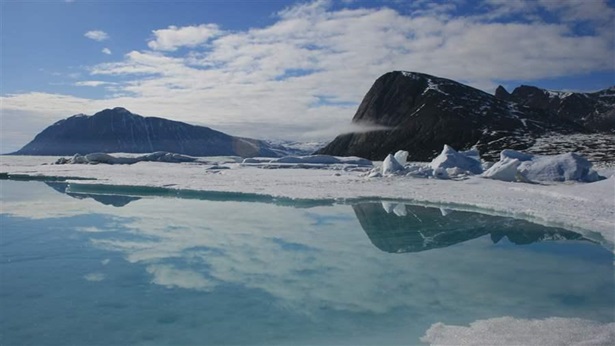Canada Moves Closer to Protecting Stunning Area of Arctic Ocean
Lancaster Sound marine park would safeguard habitat and Indigenous ways of life

Lancaster Sound, at the entrance to Canada’s Northwest Passage, is slated to become the country’s fifth national marine conservation area. Inuit hunters, integral to the protection efforts, rely upon the area’s concentration of marine mammals to sustain their traditional way of life.
© Richard Olsenius/Getty Images
In a major win for marine life and Indigenous peoples, the Canadian government announced Aug. 14 that the richest marine habitat in the Arctic Ocean—off the northern tip of Baffin Island—would soon be protected and that the boundaries would be twice as large as originally planned.
The move clears the way to safeguard 131,000 square kilometers (50,000 square miles) of waters in Lancaster Sound (Tallurutiup Tariunga in Inuktitut), which is framed by a breathtaking backdrop of tidewater glaciers; dramatic cliffs; and steep, ice-covered mountains. The announcement of the completion of a key feasibility study—the last real hurdle to protecting the sound—follows a protracted eight-year negotiation among the governments of Canada and Nunavut, and the Qikiqtani Inuit Association, which represents the more than 14,000 Inuit who live in the Baffin (Qikiqtani) region.
Lying at the eastern entrance to the Northwest Passage, the new park would be roughly 2 ½ times larger than that proposed by Prime Minister Stephen Harper’s government in 2010 and almost as big as Pennsylvania.

The protection of these Arctic waters cannot come too soon. The Arctic Ocean is warming at twice the rate of the rest of the planet, and receding sea ice is opening more maritime routes through the region and attracting more vessel traffic. For example, due to the receding summer ice cover, numerous ships will enter Lancaster Sound this year, including immense freighters hauling ore from a recently opened iron mine, cruise ships, and a Chinese icebreaker. Any spike in traffic would disrupt the fragile ecosystem and could threaten marine life and local communities’ way of life.
The story of the multigenerational effort to protect Lancaster Sound is longer than an Arctic winter night. The effort began after Canada approved oil and gas exploration across the Arctic in the late 1960s without the consent of Inuit communities. Forty-eight years later, the Harper government proposed boundaries covering 44,000 square kilometers (17,000 square miles) but excluded ecologically important areas where oil and gas leases were held by Royal Dutch Shell.
In 2016, the company abandoned those leases in Lancaster Sound under pressure from Inuit and their allies. An additional hurdle was removed later that year when the mining company Baffinland Iron Mines Corp. agreed with the recommendation of the Pond Inlet Hunters and Trappers Organization not to ship year-round in order to protect the sound when the ice cover provides critical habitat for marine mammals.
Since 2009, The Pew Charitable Trusts and Ducks Unlimited Canada, through their Oceans North Canada partnership, have worked for establishment of this conservation area. The designation would help protect the area’s ecological balance by limiting further industrial development and protect the Inuit communities in Canada and Greenland that rely upon the concentration of marine mammals to sustain their traditional way of life.
The only step remaining to formalize the protection is the negotiation of an Inuit impact and benefits agreement that should include details on employing local Inuit experts to manage and monitor the park. Such conservation jobs would make important contributions to the economies of the five adjacent Inuit communities of Pond Inlet, Arctic Bay, Resolute Bay, Clyde River, and Grise Fiord.
Completion of that agreement is expected within a year, after which Canada’s fifth national marine conservation area would serve as an international model for conservation that also would help nearby inhabitants maintain traditional subsistence activities. The Lancaster Sound marine park would be unique in that the area is the primary source of “country food” for the five Inuit communities. Locals take to the ice each spring, summer, and fall to hunt seals and birds, and use the land-fast ice to pursue narwhals and beluga whales during their migrations. Parks Canada has set a goal of establishing a conservation area to represent the full breadth of Canada’s 29 distinct marine ecosystems. The completion of the Lancaster Sound feasibility study means that, after nearly 50 years of effort, one of the most culturally significant marine ecosystems in the Canadian Arctic could soon be protected.
Steve Ganey directs Arctic marine projects for The Pew Charitable Trusts and oversees lands and ocean programs in North and South America.
Note: This post has been updated with the correct Inuktitut name for the new conservation area—Tallurutiup Imanga.


America’s Overdose Crisis
Sign up for our five-email course explaining the overdose crisis in America, the state of treatment access, and ways to improve care
Sign upThis video is hosted by YouTube. In order to view it, you must consent to the use of “Marketing Cookies” by updating your preferences in the Cookie Settings link below. View on YouTube
This video is hosted by YouTube. In order to view it, you must consent to the use of “Marketing Cookies” by updating your preferences in the Cookie Settings link below. View on YouTube











